52nd Expeditionary Flying Training Squadron
The 52nd Expeditionary Flying Training Squadron was part of the Iraq Training and Advisory Mission - Air Force. It operated Cessna and Beechcraft T-6A Texan II aircraft conducting flight training for members of the Iraqi Air Force. In late 2011, all U.S. forces were withdrawn from Iraq and the squadron was inactivated.
| 52nd Expeditionary Flying Training Squadron | |
|---|---|
 An Iraqi Air Force T-6 Texan II lands at Tikrit, Iraq | |
| Active | 1940–1944; 1944–1946; 1972–1977; 1990–1997; 2007–2011 |
| Country | |
| Branch | |
| Role | Pilot Training |
| Engagements | Pacific Theater of Operations |
| Decorations | Distinguished Unit Citation Air Force Meritorious Unit Award Air Force Outstanding Unit Award |
| Insignia | |
| 52nd Expeditionary Flying Training Squadron emblem[note 1][1] | 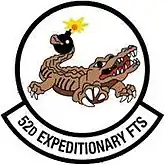 |
| 52nd Flying Training Sq emblem[2] (approved c. June 1990)[1] | .png.webp) |
The squadron was first activated in 1940 as the 52nd Bombardment Squadron in the build-up of the United States military prior to the country's entry into World War II. Following the attack on Pearl Harbor, the unit began conducting antisubmarine missions over the Gulf of Mexico. When the German U-boat threat diminished, it moved to Idaho, where it was a training unit for heavy bomber units and aircrews. In 1944, the squadron was inactivated when the Army Air Forces reorganized its training activities, but was immediately activated as a very heavy bomber unit. It deployed to the Pacific, where it earned two Distinguished Unit Citations for attacks on Japan. Following V-J Day, the squadron remained in the Pacific until inactivating in 1946.
The squadron was active again in 1972 as the 52nd Flying Training Squadron when it absorbed the resources of another unit at Craig Air Force Base, Alabama. It continued in this role until Craig closed in 1977 as the Air Force demand for pilots diminished following the end of its involvement in Vietnam. The 52nd was active again at Reese Air Force Base, Texas in the pilot training mission from 1990 to 1997. It was converted to provisional status in 2007.
History
Antisubmarine warfare
The squadron was first activated at Langley Field, Virginia, as the 52nd Bombardment Squadron in February 1940, one of the original squadrons of the 29th Bombardment Group. Its organization was part of the pre-World War II buildup of the United States Army Air Corps after the breakout of war in Europe. In May, it moved to MacDill Field, Florida, where it was equipped with a mix of pre-production YB-17s, early model Boeing B-17 Flying Fortresses and Douglas B-18 Bolos. The squadron was still at MacDill when the Japanese attacked Pearl Harbor, and it began to fly antisubmarine patrol missions in the Gulf of Mexico from January 1942.[1] By the summer of 1942, the U-boat threat in the Gulf began to diminish, with all German submarines being withdrawn from the area by September.[3]
Heavy bomber training

No longer needed in the Gulf, the squadron moved to Gowen Field, Idaho, where it became an Operational Training Unit (OTU).[1] The OTU program involved the use of an oversized parent unit to provide cadres to "satellite groups".[4] The 96th, 381st, 384th and 388th Bombardment Groups were all formed at Gowen in the second half of 1942.[5][6]
In 1943, the squadron exchanged its B-17s for Consolidated B-24 Liberators. The squadron mission also changed as the Army Air Forces' (AAF) need for new units diminished and its need for replacements increased. The squadron became a Replacement Training Unit (RTU).[1] Like OTUs, RTUs were oversized units, but their mission was to train individual pilots and aircrews. However, standard military units, like the 52nd Squadron, were based on relatively inflexible tables of organization, and were not proving well adapted to the training mission. Accordingly, a more functional system was adopted in which each base was organized into a separate numbered unit.[7] The 29th Bombardment Group and its squadrons (including the 52nd) were inactivated. Its personnel and equipment, along with that of supporting units at Gowen Field were combined into the 212th AAF Base Unit (Combat Crew Training School, Heavy) on 1 April 1944.[1][8][9]
Combat in the Pacific

The AAF was organizing new Boeing B-29 Superfortress very heavy bombardment units, and the squadron was activated the same day at Pratt Army Air Field, Kansas. It briefly returned to flying B-17s until B-29s became available for training. It continued training with the Superfortress until December 1944.[1] Training included long range overwater flights to Borinquen Field, Puerto Rico.[10]
It deployed to North Field, Guam, where it became a component of the 314th Bombardment Wing of XXI Bomber Command. Its first combat mission was an attack on Tokyo on 25 February 1945. Until March 1945, it engaged primarily in daytime high altitude attacks on strategic targets, such as refineries and factories. The campaign against Japan switched that month and the squadron began to conduct low altitude night raids, using incendiaries against area targets. The squadron received a Distinguished Unit Citation (DUC) for a 31 March attack against an airfield at Omura, Japan. The squadron earned a second DUC in June for an attack on an industrial area of Shizuoka Prefecture, which included an aircraft factory operated by Mitsubishi and the Chigusa Arsenal.[8]
Staff Sergeant Henry E."Red" Erwin of the squadron was awarded the Medal of Honor for action that saved his B-29 during a mission over Koriyama, Japan, on 12 April 1945. Sgt Erwin was assigned to job of dropping white phosphorus bombs through a launching chute in the floor of his bomber. A bomb exploded in the chute and shot back into the plane, severely wounding Sgt Erwin and filling the plane with heavy smoke. Despite being blinded by the burning bomb, he picked it up, carried it forward to the cockpit area of the plane and threw it out an open window. Once the smoke had cleared, the pilot was able to pull the Superfortress out of a dive and recover at an emergency base.[8][11]
During Operation Iceberg, the invasion of Okinawa, the squadron was diverted from the strategic campaign against Japanese industry and attacked airfields from which kamikaze attacks were being launched against the landing force. Following VJ Day, the squadron dropped food and supplies to Allied prisoners of war and participated in several show of force missions over Japan.[8] It also conducted reconnaissance flights over Japanese cities.[12] The squadron remained on Guam until it was inactivated in March 1946.[1]
Pilot training
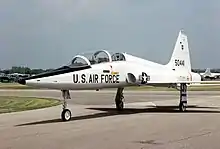
Craig Air Force Base
The 3617th Pilot Training Squadron was organized at Craig Air Force Base, Alabama in February 1956. Like its parent 3615th Pilot Training Wing, it was a Major Command Controlled (MAJCON) unit and could not retain its history once it was discontinued.[13] In 1972, Air Training Command determined to replace its MAJCON units with permanent, Air Force Controlled units. In this organizational change, on 1 July 1972, the squadron, now designated the 52d Flying Training Squadron took over the personnel, equipment and mission of the 3617th, which was simultaneously inactivated.[1][14] The squadron conducted the basic portion of Undergraduate Pilot Training with Northrop T-38 Talons. In the fall of 1977, Craig closed and the squadron was inactivated.[1]
Reese Air Force Base
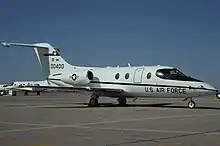
The squadron was reactivated at Reese Air Force Base, Texas in May 1990, under Air Training Command's five squadron concept, which reassigned student pilots to the wing's flying training units.[15] Under this organization, It became the second squadron flying T-38s under the 64th Flying Training Wing. With the implementation of the Objective Wing organization, the squadron became part of the wing's reactivated 64th Operations Group. With the Specialized Undergraduate Pilot Training program limiting instruction in the T-38 to students who would be flying fighter aircraft or bombers, in 1992, the squadron switched to the Raytheon T-1 Jayhawk, training students who would operate tankers and airlift aircraft. To prepare for this project, Air Education and Training Command organized the Flying Training Squadron, Provisional, 52nd at Reese, which was the first squadron to equip with the Jayhawk.[16] On 1 October, the provisional squadron was discontinued and transferred its personnel and equipment to the squadron. Training on the new plane began in January 1993. The 1995 Base Realignment and Closure Commission recommended that Reese be closed and as operations there were reduced, the squadron inactivated on 1 April 1997.[1]
Expeditionary operations
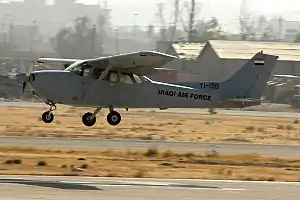
In 2007, The squadron was converted to provisional status as the 52nd Expeditionary Flying Training Squadron and activated at Kirkuk Air Base, Iraq on 29 March 2007. Its mission was to train Iraqi airmen and to conduct undergraduate and instructor pilot training for the Iraqi Air Force.[1] The squadron had established a fixed wing pilot training school by October. Its initial students, flying Cessna 172s with Iraqi Air Force markings, were both experienced military pilots, many of whom had not flown for years and who would become instructors for new Iraqi Air Force pilots, and new recruits.[17] Although the USAF had been training experienced Iraqi pilots since 2005, when the Coalition Air Force Training Team was established, the fall of 2007 marked the first training of new pilots.[18]
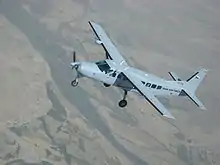
By the summer of 2008, the squadron was also training with the Cessna 208 Caravan, and increasing the tempo of training.[19] By October 2008, the first class of new pilots graduated from the fixed wing school operated by the squadron.[20]
In December 2009, the squadron moved to Camp Speicher, at Tikrit, Iraq, transferring its Cessnas to the Iraqi 201st Training Squadron.[21] At Tikrit, it was located with the Iraqi Air Force College, and began to receive Beechcraft T-6A Texan II aircraft.[22] The squadron continued its T-6 training program through September 2011, when the program was transferred to the Iraqi Air Force.[21][23]
Lineage
- Constituted as the 52d Bombardment Squadron (Heavy) on 22 December 1939
- Activated on 1 February 1940
- Redesignated 52d Bombardment Squadron, Very Heavy on 28 March 1944
- Inactivated on 1 April 1944
- Activated on 1 April 1944
- Inactivated on 20 May 1946
- Redesignated 52d Flying Training Squadron on 22 March 1972
- Activated on 1 July 1972
- Inactivated on 30 September 1977
- Activated on 11 May 1990
- Inactivated on 1 April 1997
- Redesignated 52d Expeditionary Flying Training Squadron and converted to provisional status on 23 March 2007
Assignments
- 29th Bombardment Group, 1 February 1940 – 1 April 1944
- 29th Bombardment Group, 1 April 1944 – 20 May 1946
- 29th Flying Training Wing, 1 July 1972 – 30 September 1977
- 64th Flying Training Wing, 11 May 1990
- 64th Operations Group, 15 December 1991 – 1 April 1997
- 370th Air Expeditionary Advisory Group, 29 March 2007 – 19 December 2011[23][24][25]
Stations
|
|
Aircraft
- Douglas B-18 Bolo (1940–1941)
- Boeing B-17 Flying Fortress (1940–1944)
- Consolidated B-24 Liberator (1943–1944)
- Boeing B-29 Superfortress (1944–1946)
- Northrop T-38 Talon (1972–1977, 1990–1992)
- Raytheon T-1 Jayhawk (1992–1997)
- Cessna 172 (2007–2009)
- Cessna 208 Caravan (2008-2009)[24][22][21]
- Beechcraft T-6A Texan II (2009–2011)[23]
Awards and Campaigns
| Award streamer | Award | Dates | Notes |
|---|---|---|---|
| Distinguished Unit Citation | Japan, 31 March 1945 | 52nd Bombardment Squadron[1] | |
| Distinguished Unit Citation | Japan, 19–26 June 1945 | 52nd Bombardment Squadron[1] | |
| Air Force Meritorious Unit Award | 1 June 2011-19 December 2011 | 52nd Expeditionary Flying Training Squadron[26] | |
| Air Force Outstanding Unit Award | 1 January-31 December 1973 | 52nd Flying Training Squadron[1] | |
| Air Force Outstanding Unit Award | 1 January 1976-28 February 1977 | 52nd Flying Training Squadron[1] | |
| Air Force Outstanding Unit Award | 1 October 1995-1 April 1977 | 52nd Flying Training Squadron[1] |
| Campaign Streamer | Campaign | Dates | Notes |
|---|---|---|---|
| Antisubmarine | 7 December 1941 – 25 June 1942 | 52nd Bombardment Squadron[1] | |
| American Theater without inscription | 7 December 1941–c. 6 December 1944 | 52nd Bombardment Squadron[1] | |
| Air Offensive, Japan | 17 January 1945 – 2 September 1945 | 52nd Bombardment Squadron[1] | |
| Western Pacific | 17 April 1945 – 2 September 1945 | 52nd Bombardment Squadron[1] | |
| Iraqi Governance | 29 June 2004 – 15 December 2005 | 52nd Expeditionary Flying Training Squadron[27] | |
| National Resolution | 2007 | 52nd Expeditionary Flying Training Squadron[27] | |
| Iraqi Surge | 29 March 2007 – 31 December 2008 | 52nd Expeditionary Flying Training Squadron[27] | |
| Iraqi Sovereignty | 1 January 2009 – 31 August 2010 | 52nd Expeditionary Flying Training Squadron[27] | |
| New Dawn | 1 September 2010 – 19 December 2011 | 52nd Expeditionary Flying Training Squadron[27] |
References
Notes
- Explanatory notes
- Approved 18 April 1942, reinstated June 1994.
- Citations
- Robertson, Patsy (11 September 2008). "Factsheet 52 Expeditionary Flying Training Squadron (ACC)". Air Force Historical Research Agency. Retrieved 18 December 2017.
- "Approved insignia for: 52d Flying Training Squadron". National Archives Catalog. 7 November 1990. Retrieved 19 December 2017.
- Warnock, p. 16
- Craven & Cate, Introduction, p. xxxvi
- Maurer, Combat Units, pp. 166, 269, 271, 276
- "Abstract, History 29 Bombardment Group Nov 1943". Air Force History Index. Retrieved 5 June 2018.
- Goss, p. 75
- Maurer, Combat Units, pp. 81-82
- "Abstract, History Gowen Field, Feb-Mar 1945". Air Force History Index. Retrieved 5 June 2018.
- "Abstract, History 29 Bombardment Group Jan 1945". Air Force History Index. Retrieved 6 June 2018.
- No byline. "U.S. Air Force Heritage: Master Sgt. Henry E. "Red" Erwin". United States Air Force Public Affairs. Archived from the original on 29 June 2011. Retrieved 15 June 2018.
- "Abstract, History 29 Bombardment Group Aug-Sep 1945". Air Force History Index. Retrieved 6 June 2018.
- Ravenstein, Lineage and Honors, p. 9
- See Ravenstein, Combat Wings, p. 54 (replacement of the 3615th Wing by the 29th Wing).
- A History of Air Education and Training Command, p. 328
- A History of Air Education and Training Command, p. 341
- Schonauer, Scott (22 November 2007). "Iraqi Air Force Spreading its Wings: With U.S. advisers, new flight school accepts first class of students". Stars and Stripes. Retrieved 25 December 2020.
- Frayer, Lauren (2 December 2007). "US Opens Flight School for Iraqi Pilots". Washington Post (Associated Press story). Retrieved 25 December 2020.
- Flaugh, SRA Randi (30 September 2008). "Iraqi training wing soars to 3,000th hour". 506th Air Expeditionary Group Public Affairs. Archived from the original on 15 October 2012. Retrieved 25 December 2020.
- No byline (22 October 2008). "Iraqi air force pilots take flight into history". Defence Talk. Retrieved 25 December 2020.
- Trimble, p. 67
- Marshall, SFC Tyrone C. (29 December 2009). "Iraqi Air Force College presents bright future". Task Force Wings Public Affairs. Retrieved 25 December 2020.
- Trimble, p. 70
- Lineage, including assignments and aircraft, through September 2007 in Robertson, Factsheet
- See dates for Meritorious Unit award.
- "Air Force Personnel Services: Unit Awards". Air Force Personnel Center. Retrieved 26 December 2020. (search)
- "Special Order G-33995" (PDF). United States Air Forces Central Command. 14 July 2014. Retrieved 19 January 2019.
Bibliography
![]() This article incorporates public domain material from the Air Force Historical Research Agency.
This article incorporates public domain material from the Air Force Historical Research Agency.
- Craven, Wesley F; Cate, James L, eds. (1955). The Army Air Forces in World War II (PDF). Vol. VI, Men & Planes. Chicago, IL: University of Chicago Press. LCCN 48003657. OCLC 704158. Retrieved 17 December 2016.
- Goss, William A. (1955). "The Organization and its Responsibilities, Chapter 2 The AAF". In Craven, Wesley F.; Cate, James L. (eds.). The Army Air Forces in World War II (PDF). Vol. VI, Men & Planes. Chicago, IL: University of Chicago Press. LCCN 48003657. OCLC 704158. Retrieved 17 December 2016.
- Maurer, Maurer, ed. (1983) [1961]. Air Force Combat Units of World War II (PDF) (reprint ed.). Washington, DC: Office of Air Force History. ISBN 0-912799-02-1. LCCN 61060979.
- Maurer, Maurer, ed. (1982) [1969]. Combat Squadrons of the Air Force, World War II (PDF) (reprint ed.). Washington, DC: Office of Air Force History. ISBN 0-405-12194-6. LCCN 70605402. OCLC 72556.
- Ravenstein, Charles A. (1984). Air Force Combat Wings, Lineage & Honors Histories 1947-1977. Washington, DC: Office of Air Force History. ISBN 0-912799-12-9.
- Ravenstein, Charles A. (1984). A Guide to Air Force Lineage and Honors (2d, Revised ed.). Maxwell AFB, AL: USAF Historical Research Center. (An updated, but abbreviated version of this work is available at A Guide to USAF Lineage and Honors)
- Trimble, Maj Michael M. (2019). Asymmetric Advantage: Air Advising in a Time of Strategic Competition (PDF). LeMay Papers No. 5. Maxwell AFB AL: LeMay Center for Doctrine Development and Education. Archived from the original (PDF) on 18 September 2021. Retrieved 26 December 2020.
- Warnock, Timothy. "The Battle Against the U-Boat in the American Theater" (PDF). Bolling AFB, DC: Air Force History Support Office. Archived from the original (PDF) on 7 March 2014. Retrieved 22 June 2015.
- Anonymous (2021). A History of Air Education and Training Command "The First Command" 80 Years Strong 1942-2022 (PDF). Joint Base San Antonio–Randolph AFB, TC: Office of History and Research, Air Education and Training Command. Retrieved 7 November 2022.
External links
- Aird, 2Lt Lynn (6 February 2009). "Iraqi and American pilots learn from one another". Air Education and Training Command Public Affairs. Archived from the original on 16 July 2011. Retrieved 25 December 2020.
- Allen, SSG Sanjay (28 October 2010). "Airmen train Iraqi air force instructor pilots". Air Component Coordination Element-Iraq Public Affairs. Archived from the original on 21 October 2012. Retrieved 25 December 2020.
- Bowlin, Sean; Watson, TSG Jeff (25 July 2008). "Iraqi air force reaches 2,000-flying hour milestone". 12th Flying Training Wing Public Affairs. Archived from the original on 3 August 2008. Retrieved 25 December 2020.
- Collins, Mike (31 March 2009). "Lock, load, liftoff: Skyhawks are trainers for Iraq's new air force". Aircraft Owners and Pilots Association. Archived from the original on 10 June 2011. Retrieved 25 December 2020.
- Lawrence, Quil (3 July 2009). "New Generation Of Iraqi Military Pilots Looks To Sky". National Public Radio "All Things Considered". Retrieved 25 December 2020. (audio)
- Marshall, SFC Tyrone (17 December 2009). "Iraqi Air Force College opens in Tikrit". U.S. Army Public Affairs. Retrieved 25 December 2020.
- Murlin, 2Lt Agneta (23 October 2008). "Pilot training in Iraq: a genesis story". 71st Flying Training Wing Public Affairs. Archived from the original on 1 October 2011. Retrieved 25 December 2020.
- Wall, Robert (9 November 2008). "Rebuilding IQAF Not Without Challenges". Aviation Week. Archived from the original on 22 March 2012. Retrieved 25 December 2020.
- White, SRA Dillon (9 March 2010). "Airmen to train Iraqi air force college students". US Air Forces Central Public Affairs. Archived from the original on 19 October 2012. Retrieved 25 December 2020.



.png.webp)
.svg.png.webp)